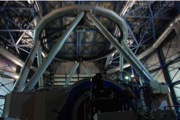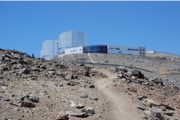The Very Large Telescope (VLT) array is the flagship facility for European astronomy at the beginning of the third Millennium. Sitting atop Cerro Paranal, its design, set of instruments and operating principles set the standard for ground-based optical and infrared astronomy.
It is the world’s most advanced optical instrument, consisting of four Unit Telescopes (UTs) with main mirrors of 8.2-m diameter and four movable 1.8-m Auxiliary Telescopes (ATs). The telescopes can work together, in groups of two or three, to form a giant ‘interferometer’, allowing astronomers to see details corresponding to those from a much larger telescope. The 8.2-m Unit Telescopes can also be used individually. With one such telescope, one can see objects that are four billion times fainter than what can be seen with the unaided eye.
The first of the Unit Telescopes, ‘Antu’, had ‘First Light’ in May 1998 and went into routine scientific operations on 1 April 1999. Today, all four Unit Telescopes and all four Auxiliary Telescopes are operational. Already, the VLT has made an unquestionable impact on observational astronomy. More than 2 000 scientific articles have appeared in peer-reviewed journals based on VLT data.
The VLT



Read more about...



Credit: G. Gillet
